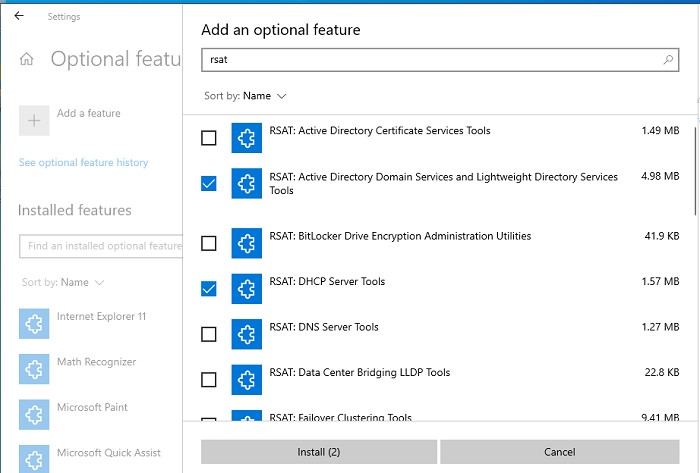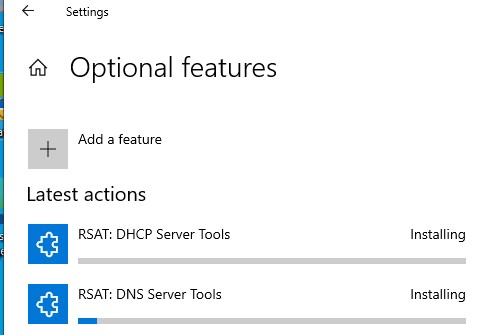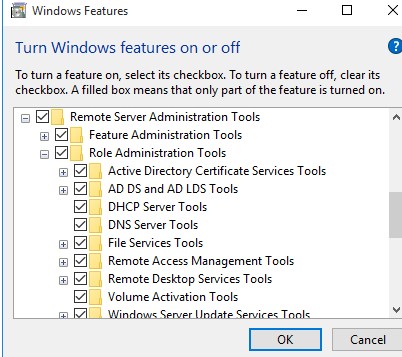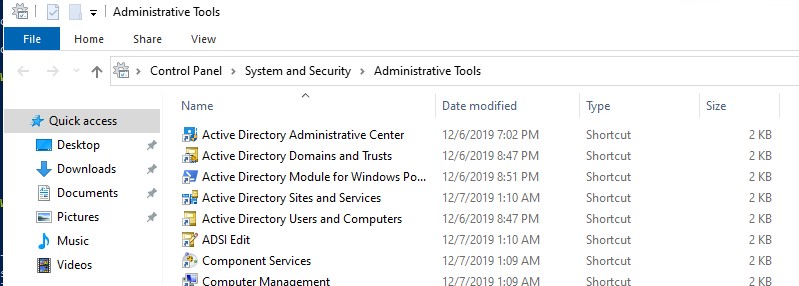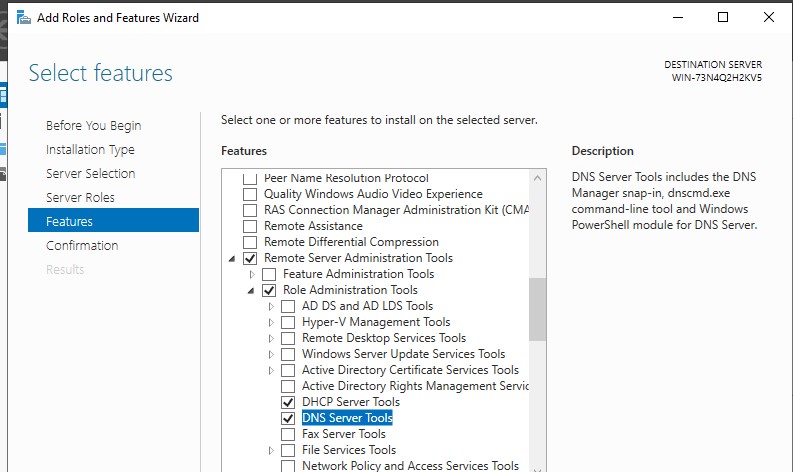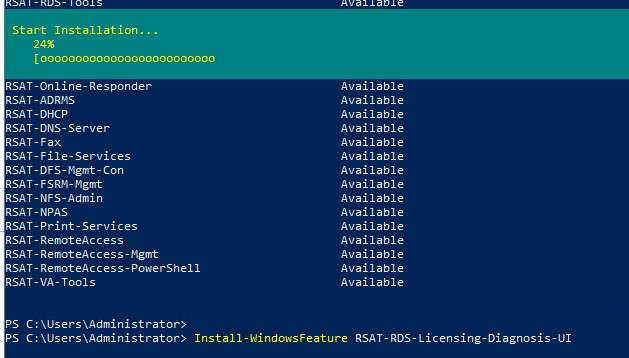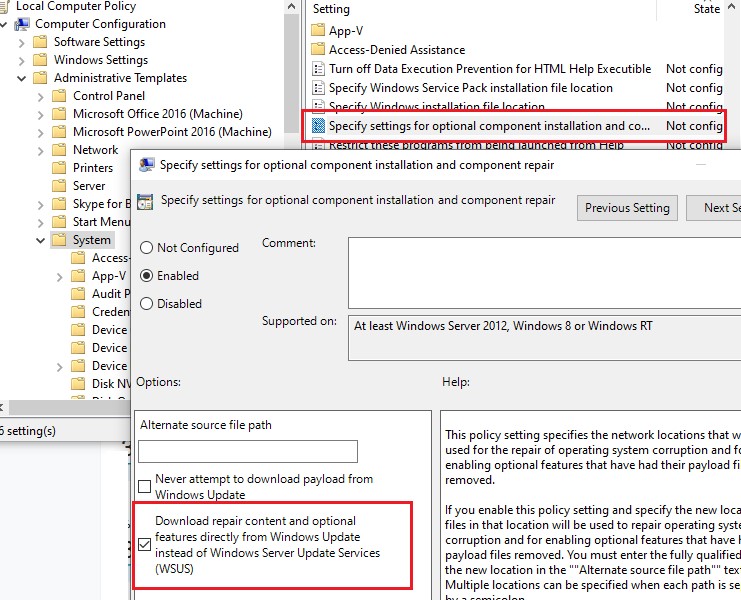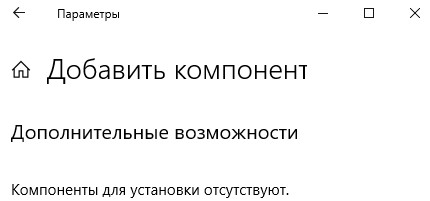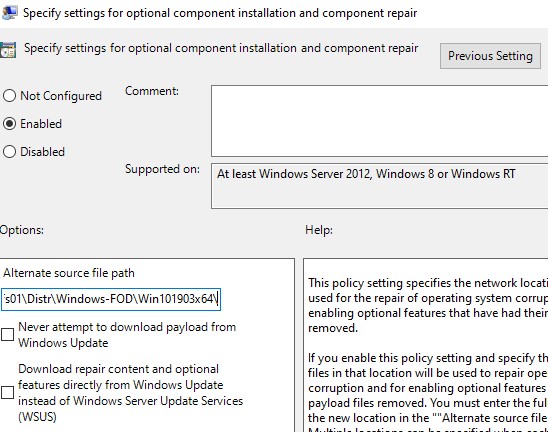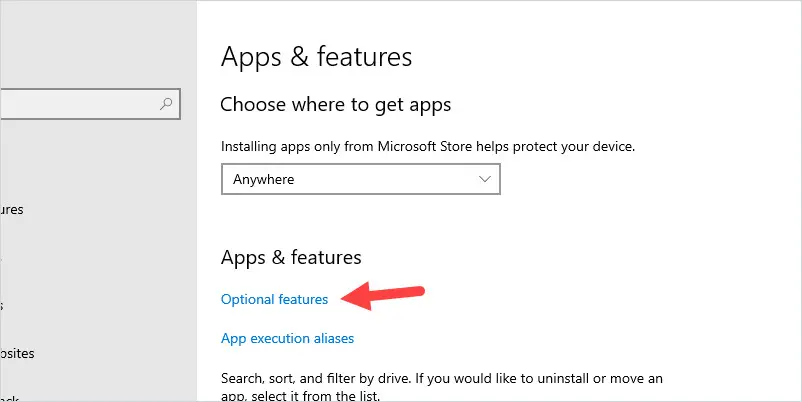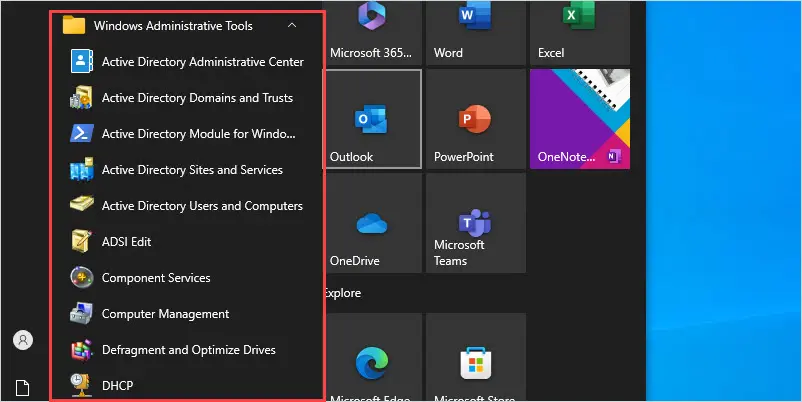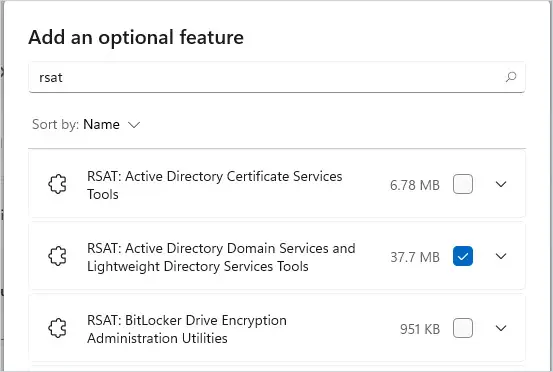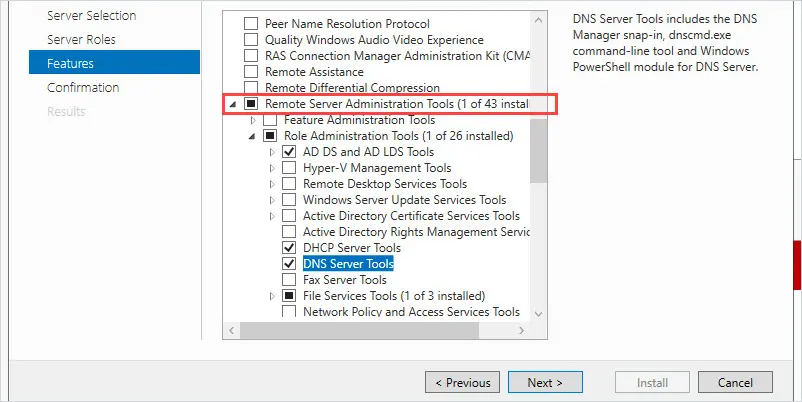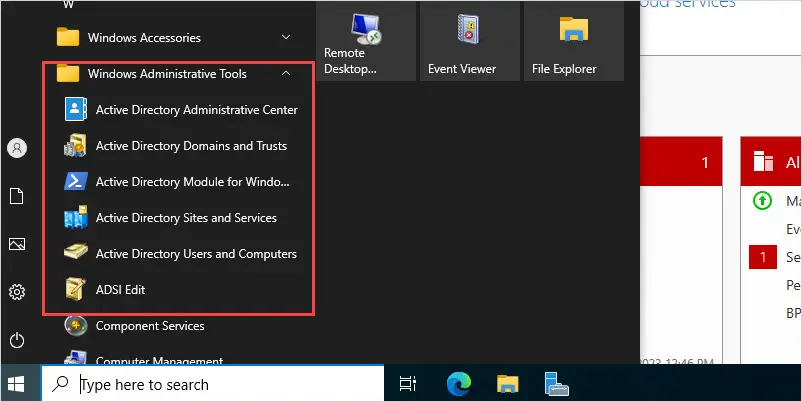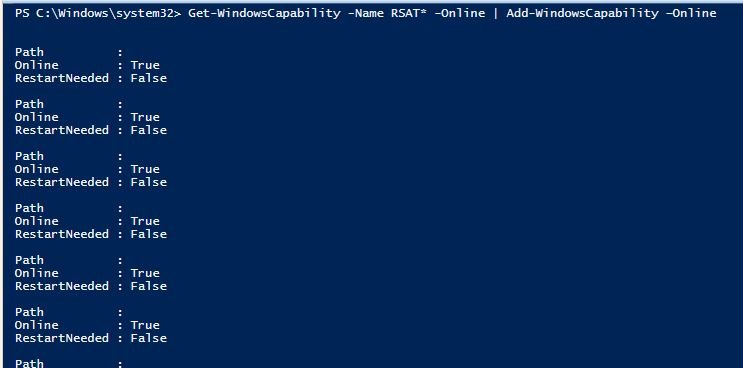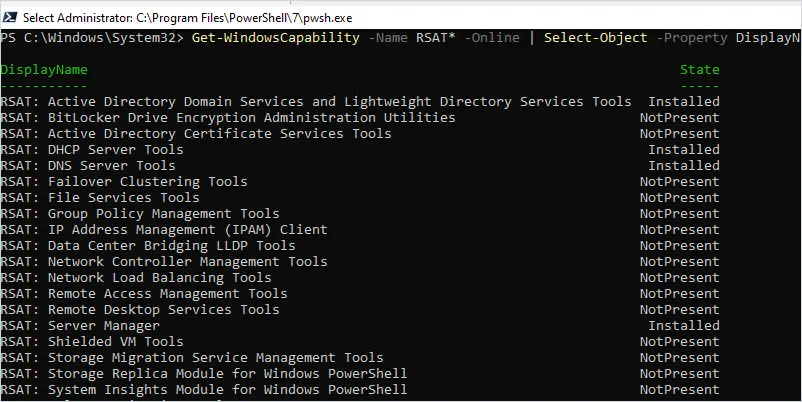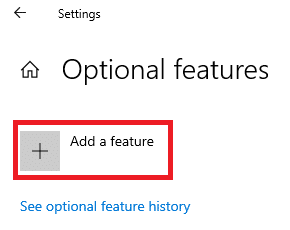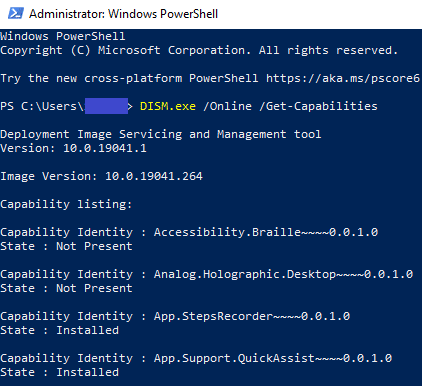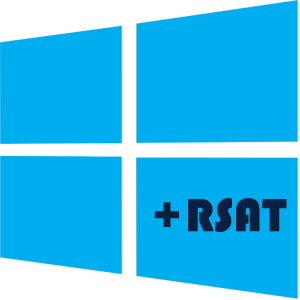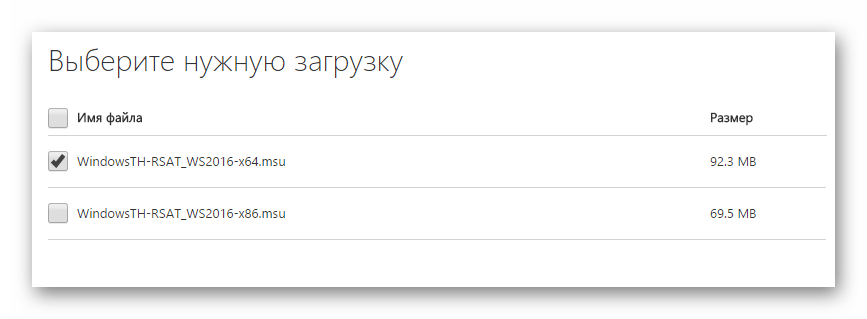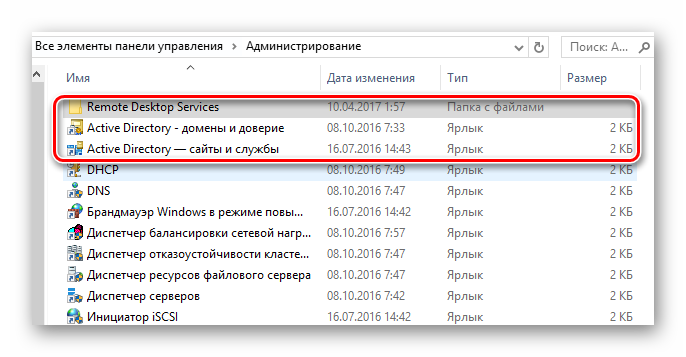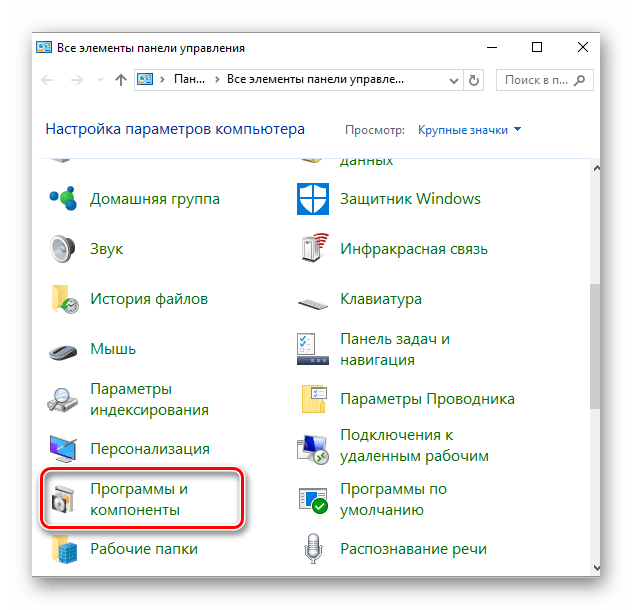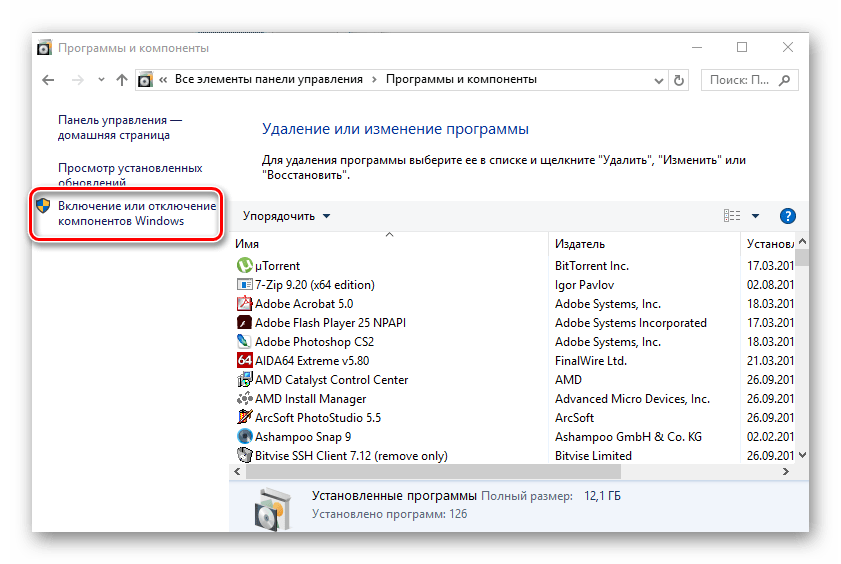Набор компонентов RSAT (Remote Server Administration Tools / Средства удаленного администрирования сервера) позволяет удаленно управлять ролями и компонентами на серверах Windows Server с обычной рабочей станции Windows. В RSAT входят графические MMC оснастки, утилиты командной строки, и модули PowerShell. Вы можете установить RSAT как на десктопных версиях Windows 10 или 11, так и в Windows Server 2022/2019/2016.
Содержание:
- Установка средств администрирования RSAT в Windows 10 и 11
- Установка RSAT в Windows с помощью PowerShell
- Как установить Remote Server Administration Tools в Windows Server 2022,2019,2016?
- Ошибка 0x800f0954 при установке RSAT в Windows
- Установка RSAT в Windows в офлайн режиме
Установка средств администрирования RSAT в Windows 10 и 11
В Windows 10 и 11 RSAT устанавливаются через графический интерфейс панели Settings -> Apps -> Optionla Features -> Add an optional feature (Параметры Windows -> Приложения -> Дополнительные возможности -> Добавить компонент).
Наберите в поисковой строке RSAT, чтобы вывести доступные компоненты. Вы можете установить в Windows 10/11 следующие инструменты администрирования RSAT:
- RSAT: Active Directory Domain Services and Lightweight Directory Services Tools
- RSAT: BitLocker Drive Encryption Administration Utilities
- RSAT: Active Directory Certificate Services Tools
- RSAT: DHCP Server Tools (настройка и управление DHCP сервером на Windows Server)
- RSAT: DNS Server Tools
- RSAT: Failover Clustering Tools
- RSAT: File Services Tools
- RSAT: Group Policy Management Tools – консоль управления GPO и PowerShell модуль GroupPolicy
- RSAT: IP Address Management (IPAM) Client
- RSAT: Data Center Bridging LLDP Tools
- RSAT: Network Controller Management Tools
- RSAT: Network Load Balancing Tools
- RSAT: Remote Access Management Tools
- RSAT: Remote Desktop Services Tools
- RSAT: Server Manager
- RSAT: Shielded VM Tools
- RSAT: Storage Migration Service Management Tools
- RSAT: Storage Replica Module for Windows PowerShell
- RSAT: System Insights Module for Windows PowerShell
- RSAT: Volume Activation Tools (консоль активации KMS сервера)
- RSAT: Windows Server Update Services Tools
Выберите нужные компоненты RSAT и нажмите Install.
Вы можете установить RSAT только Professional и Enterprise редакциях Windows 10/11, но не в Windows Home.
После установки некоторых компонентов RSAT может потребоваться перезагрузка.
Компоненты RSAT не включены в состав Windows, а поставляются в виде Функции по требованию (Features on Demand). Это значит, что для установки RSAT ваш компьютер должен быть подключен к интернету. Windows загрузит и установит необходимые файлы с серверов Microsoft Update.
В предыдущих версиях Windows (до билда Windows 10 1809) пакет удаленного администрирования серверов RSAT устанавливался в виде отдельного файла MSU обновления, которое нужно было вручную скачивать и установить с сайта Microsoft (https://www.microsoft.com/en-us/download/details.aspx?id=45520)
После установки пакета KB2693643 вы можете включить необходимые компоненты RSAT в разделе Control Panel -> Programs and Feature -> Turn Windows features on or off (
optionalfeatures.exe
). Разверните Remote Server Administration Tools и выберите необходимые компоненты для установки.
Если попытаться установить KB2693643 на более новых билдах Windows 10 или 11, появится ошибка:
Windows Update Standalone Installer encountered and error: 0x8024001d
После установки, графические mmc оснастки RSAT будут доступны в панели управления в секции Administrative Tools (Control Panel\System and Security\Administrative Tools) или в папке:
%ProgramData%\Microsoft\Windows\Start Menu\Programs\Administrative Tools
.
Установка RSAT в Windows с помощью PowerShell
Вы можете установить компоненты администрирования RSAT в Windows 10 и 11 с помощью PowerShell.
С помощью следующей PowerShell команды можно вывести список компонентов RSAT, установленных на вашем компьютере:
Get-WindowsCapability -Name RSAT* -Online | Select-Object -Property DisplayName, State
В нашем примере инструменты управления DHCP и DNS установлены (
Installed
), а все остальные модуль RSAT отсутствуют (
NotPresent
).
Для установки RSAT в Windows используется PowerShell командлет Add-WindowsCapability.
Чтобы установить конкретный инструмент RSAT, например инструменты управления AD (в том числе консоль ADUC из модуля Active Directory для Windows Powershell), выполните команду:
Add-WindowsCapability –online –Name Rsat.ActiveDirectory.DS-LDS.Tools~~~~0.0.1.0
Для установки консоли управления DNS и модуля PowerShell DNSServer, выполните:
Add-WindowsCapability –online –Name Rsat.Dns.Tools~~~~0.0.1.0
И т.д.
Add-WindowsCapability -Online -Name Rsat.BitLocker.Recovery.Tools~~~~0.0.1.0
Add-WindowsCapability -Online -Name Rsat.CertificateServices.Tools~~~~0.0.1.0
Add-WindowsCapability -Online -Name Rsat.DHCP.Tools~~~~0.0.1.0
Add-WindowsCapability -Online -Name Rsat.FailoverCluster.Management.Tools~~~~0.0.1.0
Add-WindowsCapability -Online -Name Rsat.FileServices.Tools~~~~0.0.1.0
Add-WindowsCapability -Online -Name Rsat.GroupPolicy.Management.Tools~~~~0.0.1.0
Add-WindowsCapability -Online -Name Rsat.IPAM.Client.Tools~~~~0.0.1.0
Add-WindowsCapability -Online -Name Rsat.LLDP.Tools~~~~0.0.1.0
Add-WindowsCapability -Online -Name Rsat.NetworkController.Tools~~~~0.0.1.0
Add-WindowsCapability -Online -Name Rsat.NetworkLoadBalancing.Tools~~~~0.0.1.0
Add-WindowsCapability -Online -Name Rsat.RemoteAccess.Management.Tools~~~~0.0.1.0
Add-WindowsCapability -Online -Name Rsat.RemoteDesktop.Services.Tools~~~~0.0.1.0
Add-WindowsCapability -Online -Name Rsat.ServerManager.Tools~~~~0.0.1.0
Add-WindowsCapability -Online -Name Rsat.Shielded.VM.Tools~~~~0.0.1.0
Add-WindowsCapability -Online -Name Rsat.StorageMigrationService.Management.Tools~~~~0.0.1.0
Add-WindowsCapability -Online -Name Rsat.StorageReplica.Tools~~~~0.0.1.0
Add-WindowsCapability -Online -Name Rsat.SystemInsights.Management.Tools~~~~0.0.1.0
Add-WindowsCapability -Online -Name Rsat.VolumeActivation.Tools~~~~0.0.1.0
Add-WindowsCapability -Online -Name Rsat.WSUS.Tools~~~~0.0.1.0
Чтобы установить сразу все доступные инструменты RSAT, выполните:
Get-WindowsCapability -Name RSAT* -Online | Add-WindowsCapability –Online
Также вы можете установить компоненты RSAT с помощью утилиты DISM:
DISM.exe /Online /add-capability /CapabilityName:Rsat.ActiveDirectory.DS-LDS.Tools~~~~0.0.1.0 /CapabilityName:Rsat.GroupPolicy.Management.Tools~~~~0.0.1.0 /CapabilityName:Rsat.WSUS.Tools~~~~0.0.1.0
Чтобы установить только отсутствующие компоненты RSAT, выполните:
Get-WindowsCapability -Name RSAT* -Online | where State -EQ NotPresent | Add-WindowsCapability –Online
Теперь убедитесь, что инструменты RSAT установлены (статус Installed);
Как установить Remote Server Administration Tools в Windows Server 2022,2019,2016?
В Windows Server для установки RSAT не нужен доступ в интернет. Компоненты RSAT можно устанавливать при установке соответствующих ролей или фич Windows Server, либо можно установить их через Server Manager (Add roles and Features -> Features -> Remote Server Administration Tools). Все компоненты RSAT разбиты на две секции: Feature Administration Tools и Role Administration Tools. Выберите необходимые компоненты и нажмите Next -> Next.
Для установки RSAT в Windows Server используется командлет установки компонентов и ролей — Install-WindowsFeature. Вывести список доступных компонентов RSAT в Windows Server 2022, 2019 и 2016:
Get-WindowsFeature| Where-Object {$_.name -like "*RSAT*"}| ft Name,Installstate
Для установки выбранного компонента RSAT, укажите его имя. Например, установим консоль диагностики лицензирования RDS:
Install-WindowsFeature RSAT-RDS-Licensing-Diagnosis-UI
Установить консоль удаленного управления Hyper-V Manager и PowerShell модуль Hyper-V:
Get-WindowsFeature | Where-Object {$_.Name -like "RSAT-Hyper-V-Tools"}| Install-WindowsFeature -IncludeAllSubFeature
Установленные графические консоли RSAT доступны из Server Manager или через панель управления.
Ошибка 0x800f0954 при установке RSAT в Windows
Если ваш компьютер Windows настроен на получение обновлений с локального сервера обновлений WSUS или SCCM (Configuration Manager) SUP, то при установке RSAT из графического интерфейса, Add-WindowsCapability или DISM вы получите ошибку.
В этом случае Windows будет пытаться загрузить пакет RSAT с вашего локального сервера обновлений и вернет ошибку 0x800f0954:
Чтобы игнорировать локальный WSUS при установке дополнительных компонентов Windows и Features On Demand (в том числе RSAT) нужно настроить специальный параметр групповых политики:
- Откройте редактор локальной GPO –
gpedit.msc
или используйте доменную консоль управления GPO –
gpmc.msc
); - Перейдите в раздел Computer Configuration -> Administrative Templates -> System;
- Включите политику Specify settings for optional component installation and component repair, и включите опцию Download repair content and optional features directly from Windows Updates instead of Windows Server Updates Services (WSUS) (опция “Скачайте содержимое для восстановления и дополнительные компненты непосредственно из Центра обновления Windows вместо использования службы WSUS”);
- Сохраните изменения и обновите настройки групповых политик (
gpupdate /force
). - Перезапустите службу Windows Update:
net stop wuauserv
net start wuauserv
Теперь установка RSAT через PowerShell или DISM должна выполняться без ошибок.
Некоторые параметры реестра могут блокировать подключение к Microsoft Update при получении компонентов RSAT. Если при установке RSAT появляется ошибка 0x8024002e, измените значения следующий параметров реестра в ветке
HKLM\SOFTWARE\Policies\Microsoft\Windows\WindowsUpdate
:
- DoNotConnectToWindowsUpdateInternetLocations = 0
- DisableWindowsUpdateAccess = 0
Затем перезапустите службу wuauserv.
Установка RSAT в Windows в офлайн режиме
Если вы не можете открыть прямой доступ с рабочей станции к серверам Microsoft Update, вы можете воспользоваться офлайн установкой RSAT (рекомендуется для корпоративных сетей без прямого доступа в Интернет).
Для офлайн установки RSAT нужно скачать ISO образ диска с компонентами FoD для вашей версии Windows 10/11 с сайта Microsoft или из личного кабинета на сайте лицензирования Microsoft (Volume Licensing Service Center, VLSC):
- Для Windows 10 2004 — https://learn.microsoft.com/en-us/azure/virtual-desktop/language-packs (FOD Disk 1 ISO)
- Для Windows 11 21H2/22H2- https://learn.microsoft.com/en-us/azure/virtual-desktop/windows-11-language-packs (Language and Optional Features ISO)
Например, для Windows 10 2004 x64 нужно скачать образ 19041.1.191206-1406.vb_release_amd64fre_FOD-PACKAGES_OEM_PT1_amd64fre_MULTI.iso (около 5 Гб). Распакуйте образ в сетевую папку. У вас получится набор *.cab файлов, среди которых есть компоненты RSAT.
Теперь для установки компонентов RSAT на рабочей станции Windows нужно указывать путь к данному сетевому каталогу с FoD в параметре -Source:
Add-WindowsCapability -Online -Name Rsat.ActiveDirectory.DS-LDS.Tools~~~~0.0.1.0 -LimitAccess -Source \\msk-fs01\Distr\Windows-FOD\Win101903x64\
Также вы можете указать путь к каталогу с компонентами FoD с помощью указанной выше групповой политики. Для этого в параметре Alternative source file path нужно указать UNC путь к каталогу с файлами FoD.
Или можете задать этот параметр через реестр отдельной политикой, указав путь к каталогу в параметр LocalSourcePath (тип REG_Expand_SZ) в ветке реестра HKLM\SOFTWARE\Microsoft\Windows\CurrentVersion\Policies\Servicing.
После этого, пользователи смогут самостоятельно устанавливать компоненты RSAT через графический интерфейс добавления компонент Windows 10.
Частые ошибки установки Remote Server Administration Tools в Windows
- 0x8024402c, 0x80072f8f – Windows не может поучить доступ к серверам обновления Windows для получения компонентов RSAT. Проверьте доступ в интернет или установите компоненты из локального образа FoD:
Add-WindowsCapability -Online -Name Rsat.Dns.Tools~~~~0.0.1.0 -LimitAccess -Source E:\RSAT\ - 0x800f081f – проверьте путь к каталогу с компонентами RSAT, указанному в параметре –Source;
- 0x800f0950 – ошибка аналогична 0x800f0954;
- 0x80070490 –проверьте целостность образа Windows с помощью DISM:
DISM /Online /Cleanup-Image /RestoreHealth
In this guide, I’ll show you how to install the RSAT tools on Windows 10, Windows 11, and Windows Server. I’ll also show you how to install RSAT using PowerShell.
To remotely manage Active Directory, DNS, DHCP, and other Windows features you will need the Remote Server Administration Tools (RSAT) installed.
- Install RSAT Tools on Windows 10
- Install RSAT Tools on Windows 11
- Install RSAT Tools on Windows Server
- How to Install RSAT using PowerShell
Note: Starting with Windows 10 October 2018 Update, the RSAT tools no longer need to be downloaded. They are now included with the Windows build and just need to be installed. RSAT tools are only supported on Windows Pro and Enterprise versions of Windows 10 and 11.
1. Open Apps & features and click on “Optional features”
2. Click on Add a feature.
3. Type rsat and then select the RSAT tools you want to install.
In this example, I’ll install the Active Directory, DHCP, and DNS tools.
4. Click install to start the installation.
When the installation is complete the status will say installed.
You can now navigate to the start -> Windows Administrative Tools to open one of the RSAT tools.
Install RSAT on Windows 11
On Windows 11 go to settings and then Apps.
Click on Optional Features.
Click on the View Features button.
Type in rsat and select the tools you want to install.
In this example, I’ll select the Active Directory Domain Services tool.
Click “Next”.
Click “Install”.
When the installation is complete, you can access the tools by going to all apps -> Windows Tools.
Install RSAT on Windows Server
These steps work for Server 2016, 2019, and 2022.
1. Open the Server Manager and click on Add roles and features
Click Next.
Select “Role-based or featured-based installation” and click next
Select your server and click next.
For server roles click Next. (We are not adding any server roles).
For features scroll down to Remote Server Administration Tools).
Select the tools you want to install and click next.
Confirm the selections and click install.
When the installation is complete the tool can be accessed from start -> Windows Administration Tools
Using PowerShell to Install RSAT
You can install individual RSAT tools or all of them using Powershell.
Example 1.Install all RSAT tools run the below command.
Get-WindowsCapability -Name RSAT* -Online | Add-WindowsCapability –Online
Example 2. Install Specific RSAT Tool using PowerShell
To install individual tools you will use the Add-WindowsCapability -Online -Name command followed by the PowerShell tool name.
In this example, I’ll install the Active Directory Domain Servers tools using the command below.
Add-WindowsCapability -Online -Name Rsat.ActiveDirectory.DS-LDS.Tools~~~~0.0.1.0Use the names below to install other RSAT tools via PowerShell.
Active Directory Domain Servers and Lightweight Directory Services Tools: Rsat.ActiveDirectory.DS-LDS.Tools~~~~0.0.1.0
BitLock Drive Encryption Administration Tools: Rsat.BitLocker.Recovery.Tools~~~~0.0.1.0
Active Directory Certificate Services:
Rsat.CertificateServices.Tools~~~~0.0.1.0
DHCP Server Tools:
Rsat.DHCP.Tools~~~~0.0.1.0
DNS Server Tools:
Rsat.Dns.Tools~~~~0.0.1.0
Failover Clustering Tools:
Rsat.FailoverCluster.Management.Tools~~~~0.0.1.0
File Services Tools:
Rsat.FileServices.Tools~~~~0.0.1.0
Group Policy Management Tools:
Rsat.GroupPolicy.Management.Tools~~~~0.0.1.0
IP Address Management (IPAM) Client:
Rsat.IPAM.Client.Tools~~~~0.0.1.0
Data Center Bridging LLDP Tools:
Rsat.LLDP.Tools~~~~0.0.1.0
Network Controller Management Tools:
Rsat.NetworkController.Tools~~~~0.0.1.0
Network Load Balancing Tools:
Rsat.NetworkLoadBalancing.Tools~~~~0.0.1.0
Remote Access Management Tools:
Rsat.RemoteAccess.Management.Tools~~~~0.0.1.0
Remote Desktop Services Tools:
Rsat.RemoteDesktop.Services.Tools~~~~0.0.1.0
Server Manager:
Rsat.ServerManager.Tools~~~~0.0.1.0
Shielded VM Tools:
Rsat.Shielded.VM.Tools~~~~0.0.1.0
Storage Migration Service Management Tools:
Rsat.StorageMigrationService.Management.Tools~~~~0.0.1.0
Storage Replica Module for Windows PowerShell:
Rsat.StorageReplica.Tools~~~~0.0.1.0
System Insights Module for Windows PowerShell:
Rsat.SystemInsights.Management.Tools~~~~0.0.1.0
Volume Activation Tools:
Rsat.VolumeActivation.Tools~~~~0.0.1.0
Windows Server Update Services Tools:
Rsat.WSUS.Tools~~~~0.0.1.0
You can use PowerShell to view which RSAT tools are installed with the following command.
Get-WindowsCapability -Name RSAT* -Online | Select-Object -Property DisplayName, StateYou are done. I find the PowerShell much easier.
I hope you found this tutorial useful.
Related Content
14 Must Have Active Directory Management Tools
21 Active Directory Management Tips
RSAT Tools are available for installation on Windows 10 Version 2004. If you are using Windows 10 Version 1803 or earlier, you will need to download RSAT Tools from here. RSAT Tools come as an optional feature (included in Features on Demand) in Windows 10 Version 1809 and later. It can be enabled from the settings.
Table of contents
- What are RSAT Tools?
- Install RSAT on Windows 10 using Windows Settings
- Install RSAT on Windows 10 using the command line
- How to uninstall unwanted RSAT components from Windows 10
- RSAT Alternatives
What are RSAT Tools?
Remote Server Administration Tools (RSAT) assists IT Administrators manage and monitor servers remotely from client Operating Systems like Windows 10 and Windows 7 without actually logging into the server.
RSAT tools can only be installed on Pro or Enterprise versions of the OS. If you are running Windows 10 Home, it is not available for installation.
Let’s see how the RSAT can be installed on Windows 10 Version 2004.
Install RSAT on Windows 10 using Windows Settings
- Navigate to the Start Menu –> Settings (Gear) Icon –> Apps, and then click on Optional Features.
- Click on Add a Feature
Search for RSAT on Add an Optional Feature window. You will have a series of options to choose from. Optional Features offers different components of the remote server to manage so that it is not too heavy for the operating system which you are working on (Windows 10). - Choose the components you wish to install and click Install.
- After installation is complete, restart the computer. The installed features will shift from Optional Features to Installed Features after the reboot.
The installed features are now ready for you to use!
Install RSAT on Windows 10 using the command line
PowerShell and Command Prompt can be used to view and install optional components in Windows 10.
1- View Currently Installed RSAT Components
Run Windows PowerShell and enter the following command:
DISM.exe /Online /Get-Capabilities
This command will return a series of components and their details on whether they are Installed or Not Present. Copy the name of the component you want to install.
2- Install RSAT tools using command line
Use the following command to install optional features including RSAT tools:
DISM.exe /Online /add-capability /CapabilityName:CapibilityName
Note: Replace the CapabilityName in the command above with the name of the capability identity from PowerShell. Simply copy-paste the name of the identity.
How to uninstall unwanted RSAT components from Windows 10
You can also remove or delete any unwanted features from your computer which is running Windows 10.
- Simply navigate to the following:
Start Menu –> Settings (Gear) Icon –> Apps –> Optional Features - Click on the feature you wish to remove below the Installed Features and then click Uninstall.
RSAT Alternatives
RSAT is probably the best free Active Directory management tool out there. If you are looking for RSAT tool alternatives, you can check out these tools:
- SolarWinds Access Rights Manager
- Server and Application Monitor
- Anturis
- XIA Automation
- ManageEngine ADAudit Plus
- Bulk Password Control
- Adaxes
- Quest Active Administrator
- Z-Hire and Z-Term
Do you plan on using RSAT on Windows 10? Or would you prefer managing the servers directly?
Remote Server Administration Tools (RSAT) are a collection of tools for remotely managing Windows machines. An administrator can use RSAT to manage features, roles, and role services.
RSAT is not installed on computers by default and can only be installed on Professional or Enterprise editions of the Windows machine you want to remotely operate. Using RSAT from your Windows client device, you can manage Windows Servers from a machine running Windows 10 or Windows 7 SP1 operating system. In this article, you will learn how to install RSAT on Windows 10. If you are installing Windows 10 for the first time, make sure your system meets the minimum requirements for installing this OS. Alternatively, you can choose to host your Microsoft Windows server on a dedicated servers, such as the ones offered by ServerMania.
Using Microsoft Windows server tools offers network admins a range of benefits. These remote management tools for Windows 10 help save a great deal of time for system administrators. With Microsoft administration tools, you have the flexibility of managing and monitoring the system without being near the actual machine. With the help of RSAT role administration tools, directory tools, services tools, and other administration tools in Windows, you can create new users, modify user grants & privileges, reset user passwords, and more from any remote location, as long as you have a stable connection to the internet. Microsoft Windows administration tools can be used, not only from your Desktop PC or your laptop but can also be used from a smartphone or a tablet. For more information about RSAT compatibility for different operating systems, please reference the official documentation.
Your system administrators can much better spend their time on improving processes and solving operational challenges. So with that in mind, let’s install Remote Server Administration Tools. There are two ways to install RSAT on a Windows 10 machine:
See Also: (Live Webinar) Meet ServerMania: Transform Your Server Hosting Experience
Installing RSAT on Windows 10 using Windows Settings
Since the October 2018 Windows Update, RSAT comes included as a set of on-demand features, which means that you don’t need to download RSAT online. To get started, click on the Start Menu → Settings → Apps. You will arrive at the list of Apps & Features. The default view will list the installed apps on your system. The list will be preceded by two links → Optional features & App execution aliases.
Use the Optional features link to see the list of installed features. As mentioned already, RSAT is an optional feature, so it is not installed by default. Click the Add a feature button, which is found right above the list. It will open a search dialog box. It will list all the features available for installation. Just search features related to RSAT by typing ‘RSAT’ in the search box.
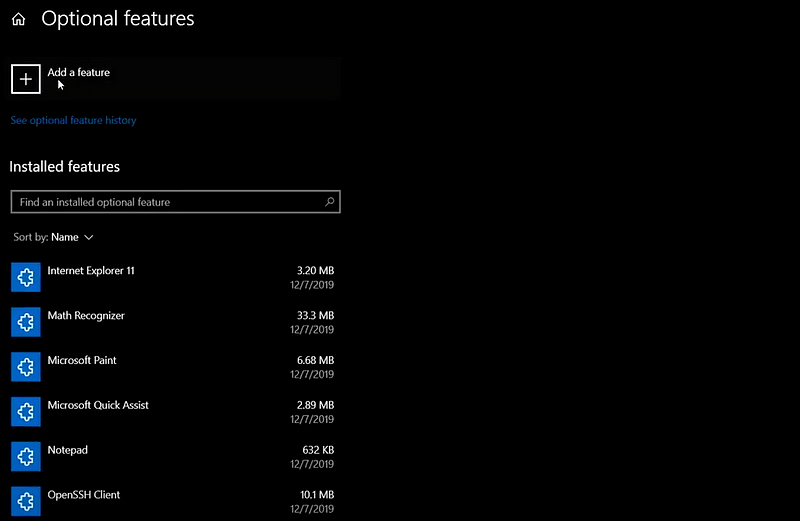
You don’t have to install the whole set of tools. You can selectively choose the tools and install them. For instance, you can choose RSAT: DNS Server Tools and RSAT: DHCP Server tools only and install these. Once the installation is complete, you can go to Windows Administrative Tools to verify if the installation has been successful and see whether the Remote Server Administration Tools are available for use.
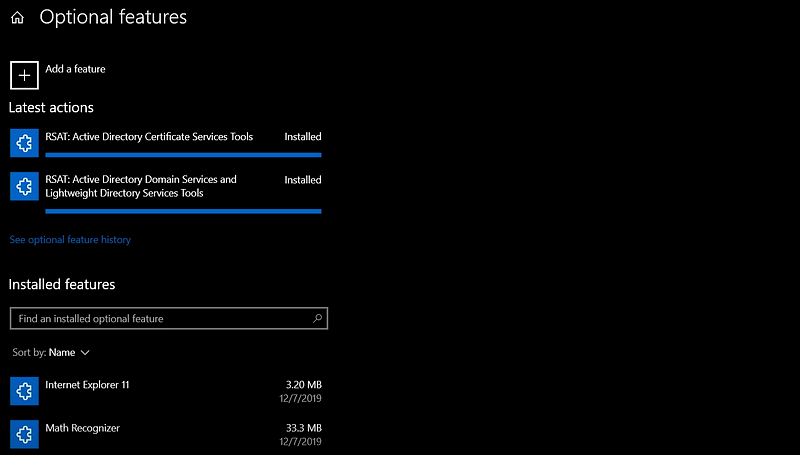
As you can see, the Add a feature button can be used to selectively manage optional features and turn windows features on. These features can range anywhere from active directory domain services to group policy management, and from remote desktop administration to lightweight directory management. You can look into the full list of optional features related to Remote Server Administration Tools in different versions of Windows in the official documentation.
Installing RSAT on Windows 10 using PowerShell
RSAT for Windows 10 can also be installed using the command line, i.e., Windows PowerShell. For power users, using command-line tools is usually a preferable option when compared with the GUI alternative. The fact that the complete installation is scriptable makes this option so attractive to the power users.
Using PowerShell cmdlets to List Administration Tools for Windows
Open a PowerShell terminal and use one of the Windows PowerShell cmdlets called WindowsCapability module to find the list of optional features that contain the phrase RSAT:
Get -WindowsCapability -Online -Name “Rsat*”
Selecting Properties of Optional Features
The above command will list all the properties of the optional feature. The properties include description, capability name, sample package name, satellites, install size, and availability (OS-availability). For instance, let’s look at all the properties listed for the RSAT component used to manage the Remote Access role on Windows Server:
Description: Graphical and PowerShell tools for managing the Remote Access role on Windows ServerDependencies: Rsat.ServerManager.Tools, Rsat.GroupPolicy.Management.ToolsCapability name: Rsat.RemoteAccess.Management.Tools~~~~0.0.1.0Sample package name: Microsoft-Windows-RemoteAccess-Management-Tools-FoD-Package~31bf3856ad364e35~amd64~~.cabSatellites: YesInstall size: 27.70 MBAvailability: Windows 10, version 1809 and later

Reducing Wealth of Properties Output
To reduce the long output list slightly, you can choose to select some of the properties by using the following command:
Get -WindowsCapability -Online -Name “Rsat*” | select name,description | fl
The output of the command above will result in a list that will contain some of the following entries, and more:
Name : Rsat.ActiveDirectory.DS-LDS.Tools~~~~0.0.1.0Description : For remotely managing AD DS and AD LDS on Windows ServerName : Rsat.BitLocker.Recovery.Tools~~~~0.0.1.0Description : Tools for managing BitLocker Drive Encryption FeaturesName : Rsat.Dns.Tools~~~~0.0.1.0Description : DNS MMC snap-in, dnscmd.exe command-line tool, and Windows PowerShell module for DHCP ServerName : Rsat.GroupPolicy.Management.Tools~~~~0.0.1.0Description : Group Policy Management Console, GP Management Editor, and GP Started GPO Editor
Choosing Remote Server Administration Tools Features to Install
Just like in the GUI management console, you can choose the features you want to install. For instance, to install all the features related to RSAT on Windows 10, you can simply run the following command:
Get -WindowsCapability -Online -Name “Rsat*” | Add-WindowsCapability -Online
On the other hand, if you want to be selective and install either a single package or a group of related packages, you can use one of the following commands:
Get -WindowsCapability -Online -Name “Rsat.Dns.Tools~~~~0.0.1.0” | Add-WindowsCapability -OnlineGet -WindowsCapability -Online -Name “Rsat*Dns” | Add-WindowsCapability -Online
Verifying Installed Server Administration Tools Features
Once the installation is done, you can verify the installation by running the following command which lists the installed features:
Get -WindowsCapability -Online -Name “Rsat*” | where -Property state -eq installed | select displayname,name,description
Using PowerShell cmdlets is a simple method to install and verify additional features. Alternatively, you can always go to Windows Administrative Tools and check if the new features have been installed and are visible there.
Ready To Get Going
With the above information in your hand, you should now be able to install RSAT on your own Windows 10 machine using one of the two methods discussed. This will enable you to manage your Windows server effectively from any remote location given you have a stable internet connection.
Are you looking for a dedicated server to run all of this on? Simply contact our team of server experts, who will be more than happy to help you get started.
Содержание
- Инструкция по установке RSAT на Виндовс 10
- Шаг 1: проверка аппаратных и системных требований
- Шаг 2: скачивание дистрибутива
- Шаг 3: инсталляция RSAT
- Шаг 4: активация функций RSAT
- Вопросы и ответы
RSAT или Remote Server Administration Tools — это специальный набор утилит и инструментов, разработанных компанией Microsoft для удаленного управления серверами на базе ОС Windows Servers, доменами Active Directory, а также другими аналогичными ролями, представленными в данной операционной системе.
RSAT, в первую очередь, будет необходим системным администраторам, а также тем пользователям, кто хочет получить практический опыт, связанный с работой серверов на базе Виндовс. Поэтому, если Вам это нужно, следуйте инструкции по установке этого программного комплекса.
Шаг 1: проверка аппаратных и системных требований
RSAT не устанавливается на ОС Виндовс Home Edition и на ПК, которые работают на базе ARM-процессоров. Удостоверьтесь, что Ваша операционная система не попадает в этот круг ограничений.
Шаг 2: скачивание дистрибутива
Скачайте средство удаленного администрирования с официального сайта корпорации Майкрософт c учетом архитектуры Вашего ПК.
Скачать RSAT
Шаг 3: инсталляция RSAT
- Откройте скачанный ранее дистрибутив.
- Согласитесь с установкой обновления KB2693643 (RSAT ставится как пакет обновлений).
- Примите условия лицензионного соглашения.
- Дождитесь завершения процесса установки.
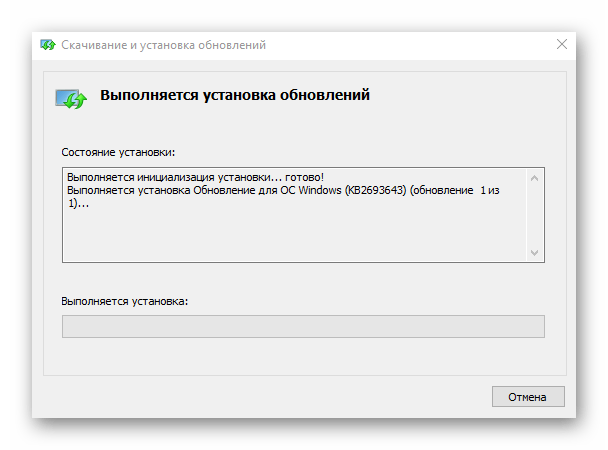
Шаг 4: активация функций RSAT
По умолчанию, Виндовс 10 самостоятельно активирует инструменты RSAT. Если это произошло, то в Панели управления появятся соответствующие разделы.
Ну а если, по какой-либо причине, средства удаленного доступа не активировались, то выполните такие действия:
- Откройте «Панель управления» через меню «Пуск».
- Кликните по пункту «Программы и компоненты».
- Далее «Включение или отключения компонентов Windows».
- Найдите RSAT и поставьте напротив этого пункта отметку (галочку).
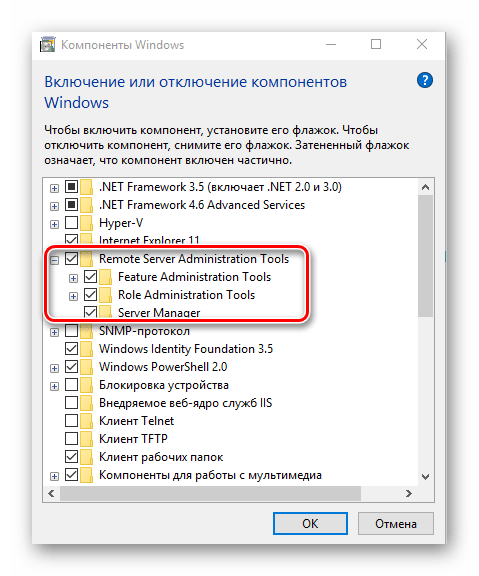
После выполнения этих шагов можно использовать RSAT для решения задач удаленного администрирования серверов.
Еще статьи по данной теме:
